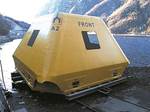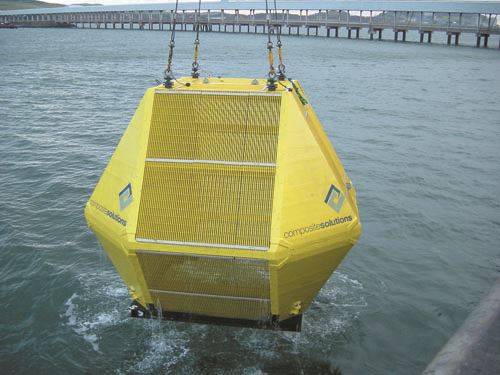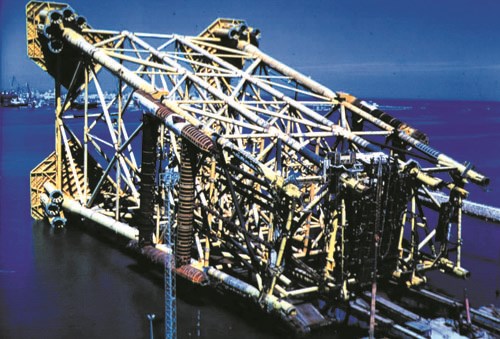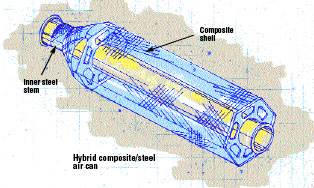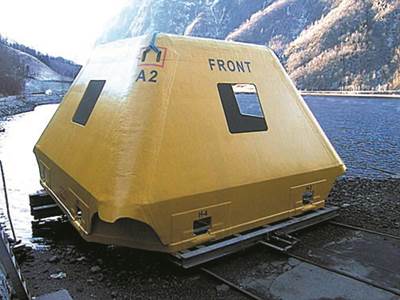Design Issues With Subsea And Downhole Components
For structures below the water line and in the borehole, composites add to their list of benefits the key characteristic of design flexibility, because composite materials can be tailored to meet specific challenges. For example, composites can add buoyancy to low-pressure steel air cans on a spar platform’s r
For structures below the water line and in the borehole, composites add to their list of benefits the key characteristic of design flexibility, because composite materials can be tailored to meet specific challenges. For example, composites can add buoyancy to low-pressure steel air cans on a spar platform’s riser string. A new hybrid air can design uses composites to reduce weight and enhance buoyancy, while incorporating steel to withstand the loads caused by wave action — anywhere from 50,000 to 2 million lb/225 to 9,000 kN — that could occur if the can impacts the vertical riser support guides within the spar hull.
Riser buoyancy elements are a major part of any semisubmersible or drill ship because they represent a significant portion of the overall cost of production risers. As drilling and production moves to deeper water, buoyancy plays an increasingly important role in reducing riser top tension loads and floating vessel connection loads. Early versions were made with low-density blown polyurethane or polyvinyl chloride (PVC) foams contained within a shell. But they often could not stand up to the hydrostatic loads at water depths greater than 1,000 ft/300m and would fracture and break up under impact or flexure caused by drill string running. Newer-generation modules incorporate high-density syntactic foams and high-performance composite shells. These are stronger and exhibit minimal water ingress, even at depths approaching 10,000 ft/3,000m. While modular buoyancy does improve the durability and impact resistance of the riser, it tends to increase the riser drag-to-weight ratio, as well, which can affect the dynamic response of the riser string. A joint industry task force has been formed to produce a specification regarding buoyancy and insulation, led by MCS International (Galway, Ireland; Aberdeen, Scotland, U.K. and Houston, Texas, U.S.A.), a firm specializing in offshore systems computer analysis.
Large (up to 3,400 lb/7,500 kg and more than 20 ft/6m in length) riser arch support trays are another example of successful and cost-effective integration of structural composite parts into a platform system. Composite trays were cheaper than the steel equivalent for one North Sea installation because their relatively complex shape was less expensive to fabricate in composites than in steel. Plus, lower weight means that the riser support system has a lower center of gravity, which simplified barge installation. The difficulty of servicing subsea structures makes low-maintenance composites a very attractive option, as well.
Wellhead protection covers are a good example of a composite application that clearly out-performs steel. They are employed in the North Sea where fishing trawlers operate, to prevent nets and clump weights from damaging subsea wellheads and valves. A smaller, lighter-weight composite cover can provide the same protection as a steel cover, with a smaller footprint, and can be more easily hinged open by subsea remotely operated vehicles (ROVs) during maintenance. In addition, composite covers do not require cathodic protection for corrosion control.
In recent years, composites have quietly expanded into downhole tool applications. Several oilfield suppliers offer logging tools, packers, sucker rod guides, bridge plugs and other equipment made from both reinforced thermoset and thermoplastic resins. Composite tools are lighter and easier to work with, and are much faster and easier to drill through when the work is complete. They offer corrosion resistance and electromagnetic transparency — important properties in a part used for downhole logging and data transmission.
Because downhole temperatures can reach in excess of 350°F/176°C, thermoplastic resins are often selected because of their excellent high-temperature performance, even in the presence of corrosive chemicals, although epoxies perform well up to 250°F/120°C. Polyetheretherketone (PEEK) and polyphenylene sulfide (PPS) are the thermoplastics most commonly used for downhole tools at elevated temperatures, says James Mondo of Automated Dynamics (Schenectady, N.Y, U.S.A..), a supplier of thermoplastic downhole tools and parts. “Semi-crystalline resins like PEEK and PPS both exhibit outstanding chemical resistance, even at elevated temperatures above their glass transition temperatures,” he explains, adding that, under high loading, PPS can be used up to 300°F/150°C and PEEK can be used up to 400°F/204°C.
Related Content
Manufacturing the MFFD thermoplastic composite fuselage
Demonstrator’s upper, lower shells and assembly prove materials and new processes for lighter, cheaper and more sustainable high-rate future aircraft.
Read MorePrice, performance, protection: EV battery enclosures, Part 1
Composite technologies are growing in use as suppliers continue efforts to meet more demanding requirements for EV battery enclosures.
Read MoreCarbon fiber in pressure vessels for hydrogen
The emerging H2 economy drives tank development for aircraft, ships and gas transport.
Read MoreTU Munich develops cuboidal conformable tanks using carbon fiber composites for increased hydrogen storage
Flat tank enabling standard platform for BEV and FCEV uses thermoplastic and thermoset composites, overwrapped skeleton design in pursuit of 25% more H2 storage.
Read MoreRead Next
Subsea And Downhole Components
Composite buoyancy elements, riser arch trays, wellhead enclosures and downhole parts meet service challenges.
Read MoreSubsea Wellhead And Pipeline Protection Covers
Wellhead and pipeline protection covers are required under the Norsok regulations for subsea installations in the Norwegian sector (Standard U-002, Subsea Structures and Piping System). Traditional steel wellhead covers are very large — often more than 50 ft/15m square — to allow ROVs access to the Christmas t
Read More

